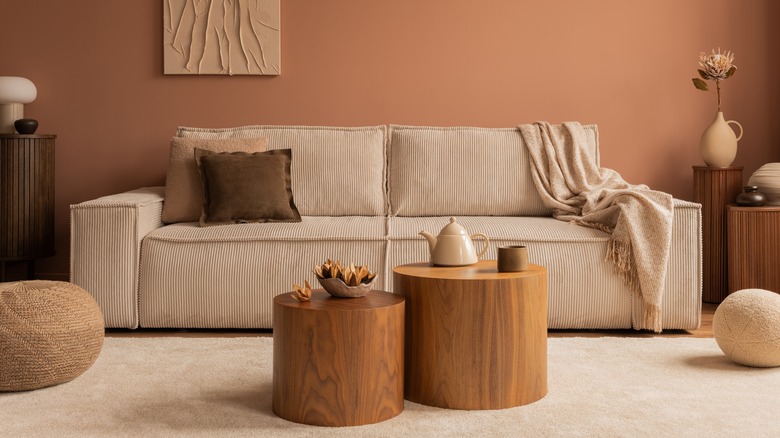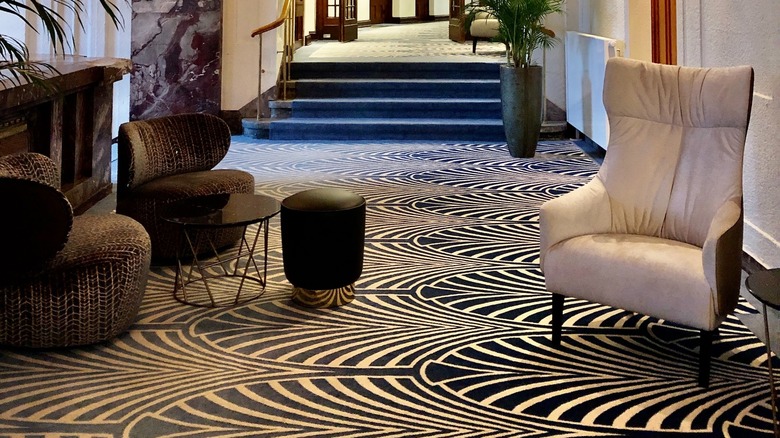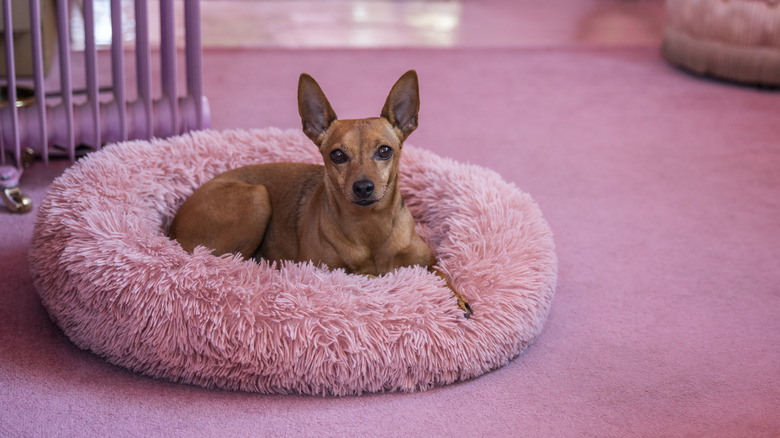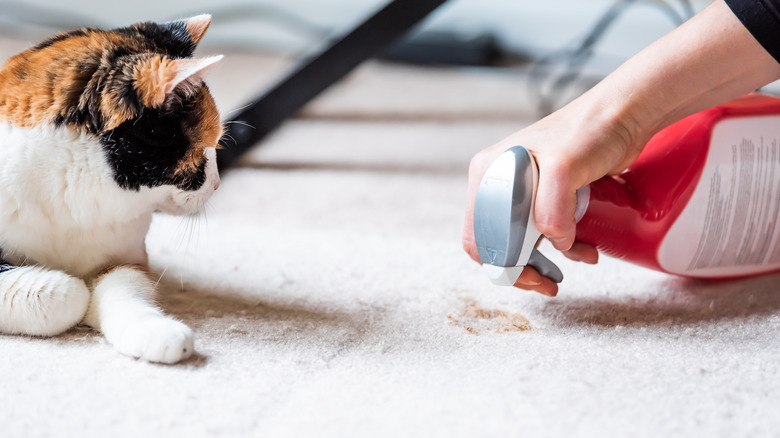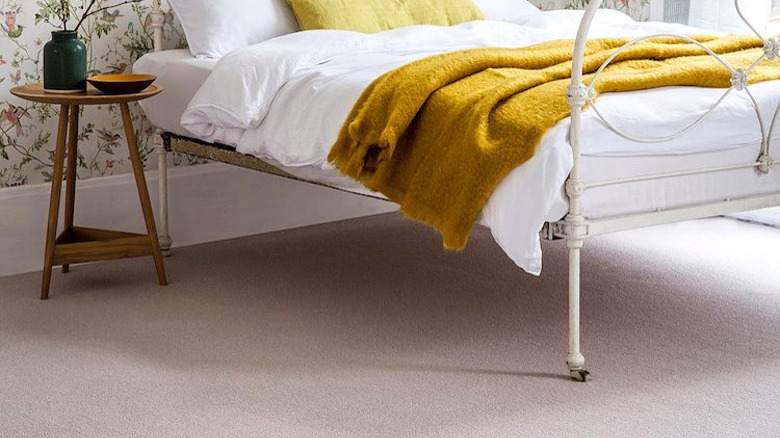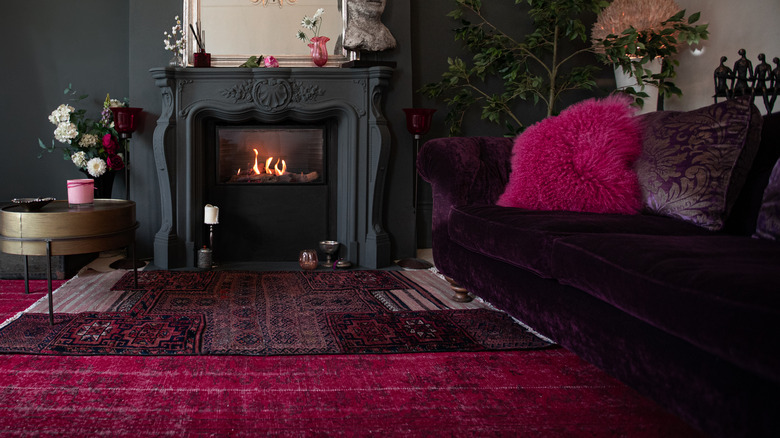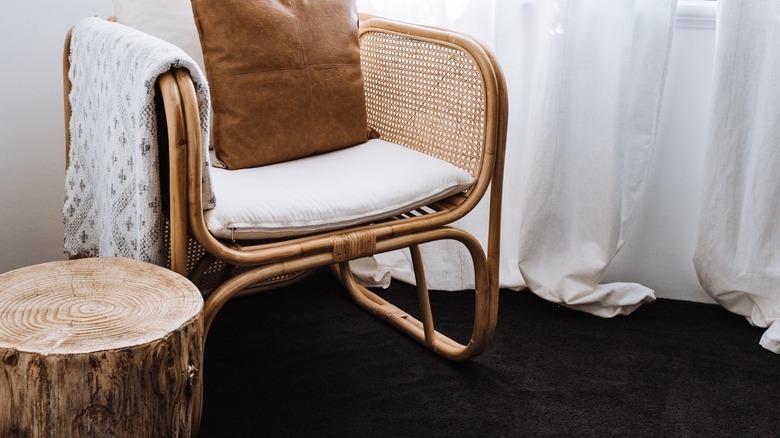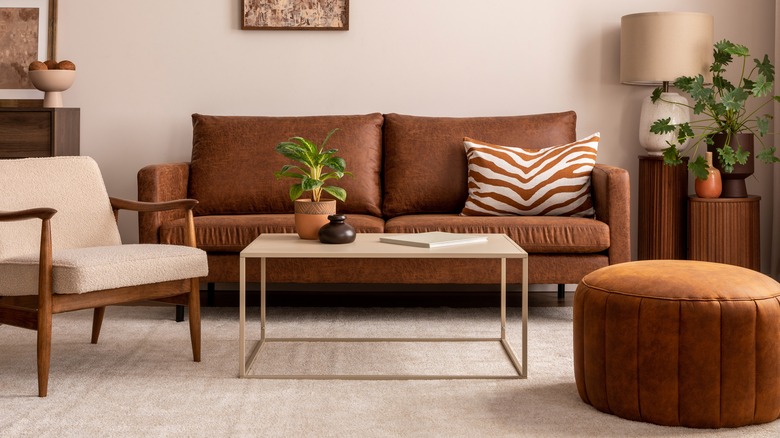Carpet Colors You Should Avoid, According To Our Design Experts
When it comes to flooring options, carpet offers a few advantages over hardwood and other hard flooring types. It's soft underfoot, provides sound dampening, emits a warm and cozy vibe, and does not cost as much as hardwood floors. When you decide to install the cushiony flooring, you're faced with a plethora of color choices. To rule out colors that may cause problems, we consulted with several home professionals to get their list of what to steer clear of. Spending your budget on these hues may cause you to regret your decision down the road.
For example, if your concern is avoiding something high maintenance, certain shades will highlight stains and pet hair like a spotlight. But if you're more worried about longevity, particular hues and patterns might make your space feel dated in a handful of years, prompting another discussion about remodeling. Or, if you like to tinker and redecorate your rooms a lot, a couple of shades might make the task more difficult. Here are the carpet colors you should avoid, depending on your needs.
Patterned designs
Patterned carpets feature geometrical patterns with two or more contrasting colors juxtaposed against each other. They make a bold statement and help take an ordinary room into playful, maximalist territories. However, it's a good idea to think twice before taking this approach. It locks you into a limited design, so unless you're willing to pour significant time and energy into figuring out what furniture will match, you might want to choose something less demanding.
That's why interior design experts warn against using colorblock carpeting. "Most colorblock designs are very bold, so you need to match this with your furniture. The colors can sometimes be too strong, so they become an eyesore, especially if they are not balanced with other items in your room," warns Vickie Larue of Paintthesis.com. Decorating will become a puzzle, one where you'll need to consult the color wheel before buying a piece of decor. Plus, it might not age well. "They also become outdated quite fast," she warns. While the colors might be popular today, they can seem out of step within a couple of years. If you want to invest in carpeting that lasts for a decade, this might not be the best route.
Trendy colors, such as Barbie Pink or Ultra Violet
It's fun to follow color trends; they make you feel plugged into the changing times and allow you to get creative. But when you're choosing new carpeting, it's wise to resist the urge to follow fads. Carpet installation represents a major monetary investment for your home, and you don't want to repeat the expenditure on a frequent basis. Most carpets are made to last for five to 15 years, depending on quality, cushioning, and usage. So before you buy the Barbie Pink wall-to-wall carpeting, ask yourself: "Will I truly like this in five years?"
If you're swept away with the idea of Raspberry Blush and are itching to make a bold design move with similar carpeting, take that color to the ceiling with paint. It will create a similar vibe, but is easily reversible once the appeal wears off. Much like how we now blanch at avocado shag carpeting from the '70s, you don't want to be stuck with punchy carpeting that feels dated.
Pure white
Gorgeous photos of elegant interiors with pristine white carpets grace the pages of home decor magazines and websites. However, in real life, you might want to think twice before selecting pure white as your carpet color, especially in high-traffic areas. "While white carpets exude elegance and sophistication, they are incredibly challenging to maintain. White is prone to showing every speck of dirt, stain, or discoloration, making it a high-maintenance option," says Cam Dowski, real estate investor and founder of WeBuyHousesChicago.Co. "Unless you're prepared to invest significant effort in regular cleaning and upkeep, it's advisable to choose more forgiving hues."
Artem Kropovinsky, interior designer and founder of Arsight, also points out that the color doesn't lend itself to a cozy ambiance. "While they can give a room a fresh, airy feel, matching other elements can be a challenge without making the room feel cold or sterile," he says. If your heart is set on a snow-white carpet, try installing it in a room that gets little foot traffic. You might put it in a guest room or parlor, where children and pets do not typically play.
Very light pastels
Similar to white carpets, the choices in the pale-pastel color palette look beautiful when the carpet is new and staged for an interior design photo. But in real life, very light pastels do not hold up well. In addition to accumulating dirt and stains from foot traffic and spills, the pastel colors lose their vivid quality when exposed to sunlight. "Pastel-colored carpets, especially in sunlit rooms, are prone to fading over time, losing their charm and vibrancy," shares Kropovinsky.
If you plan to sell your home within the next five years, very-light pastel carpet may be an unwise choice for resale value. Although a pretty pastel color might complement your personal aesthetic at the moment, it's not a choice that many homebuyers would look for, meaning you have limited your buyer pool. For example, when conducting an interior paint color analysis, Zillow found that the best-selling houses had white kitchens, gray living rooms, and blue bathrooms, all of which are quiet neutrals. Ultimately, the pale pastel carpet could negatively influence your home resale experience.
Bright, bold colors like red or purple
If you're going for a dramatic and lively decor aesthetic, you might be drawn to bright and bold carpet colors. For example, baby blue carpeting is unique, and might be just the color to help your brown velvet sofa pop. But designers suggest you think twice about choosing these vivid hues, unless you plan to keep the room as is for years without any tweaks. "
If you like to frequently update your rooms or tinker with your accents, then this can limit your options. Vibrant colors will keep you beholden to a certain section of the color wheel, potentially leading to a disorganized look. If you love bold colors and want to bring them into the interior design for your living spaces, you can use them in elements other than the carpet. "Opting for a neutral carpet with bold accent pieces is often a more sustainable choice," says Kropovinsky.
Very dark colors
If you want to avoid frequent vacuuming and carpet cleaning, you might be considering installing a carpet in a dark color. Stains and dirt won't be as readily visible, right? However, the result will be the opposite of what you'd expect. "Dark carpets can make dust and lint more visible, requiring regular vacuuming," warns Kropovinsky. Black or dark brown carpets will serve as a contrasting backdrop to highlight every piece of debris that foot traffic brings into your home. This is doubly true if you have pets with pale fur.
In addition to being higher maintenance, carpets in very dark colors can negatively affect the overall vibe of your living space. "Extremely dark colors can make a room feel smaller and less inviting, which may not work in already compact spaces," Kropovinsky shares. By contrast, carpets in neutral colors tend to make rooms feel more open and comfortable.
What to choose instead
Having ruled out the carpet colors that design experts warn against, you may be wondering what colors you should choose. You want to stay in the middle, forgoing anything too light or too dark.
A neutral-color carpet will last through years of decor changes, such as painting your room a different color or buying a new couch. It will serve as a pleasant backdrop for multiple color choices in furniture, upholstery fabric, curtains, and accessories. On top of that, neutrals tend to make a room feel larger. Plus, neutral-color carpets may give you a positive return on your investment. Since 80% of buyers want a move-in ready home, the last thing they will want to do is rip out wall-to-wall carpeting. But since neutrals work with just about any aesthetic, they will more likely be pleased with your carpet choice and more readily put in an offer. When in doubt, go neutral.
